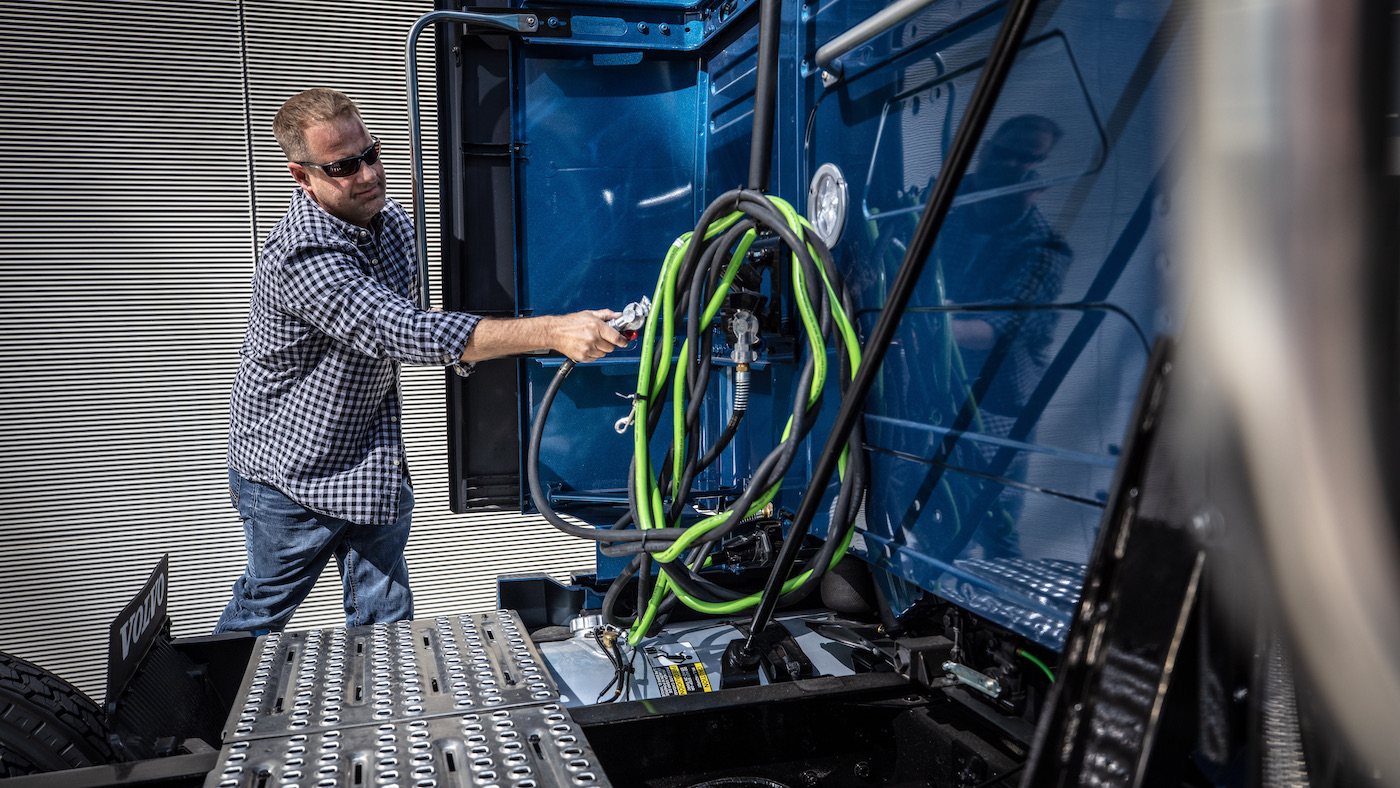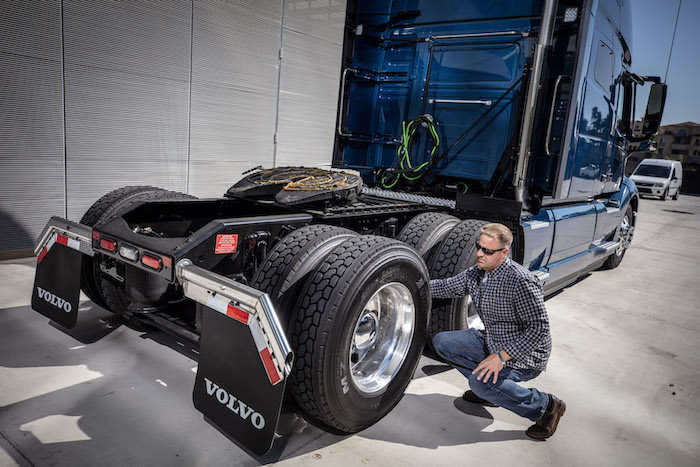The Importance of Pre-Trip Inspections for Fleet Safety

It is no question, the safety of commercial fleets and their drivers is paramount. These vehicles often traverse vast distances while carrying vital goods and commodities or embark on frequent trips providing services that sustain our daily lives. All in all, it’s a lot of mileage, and with that frequent exposure to the dangers of the road.
To ensure the safety and well-being of drivers, pedestrians, and fellow motorists, pre-trip inspections for trucks and commercial vehicles alike have emerged as a federally mandated necessity in comprehensive safety protocols for fleets of all sizes.
On top of safety, fleets must also stay on schedule. To that end, we’ve put together a list of the most important aspects of pre-trip fleet inspections that not only explains, “What is a pre-trip inspection?” but also the significance of an engine compartment and in-cabin pre-trip inspection. This includes the simple steps to ensure your fleet maintains the highest standards of safety, no matter the industry.
What is a pre-trip inspection?
A pre-trip inspection is a systematic review of a vehicle using either a company provided checklist or the standard mandated FMCSA pre-trip inspection checklist to evaluate the fleet vehicle’s condition before it embarks on a journey. This inspection is typically performed by drivers or maintenance personnel to make certain that the vehicle is in good working order, meets safety standards, and is ready for the road.
Fleet inspections are crucial for all commercial vehicles, whether it be trucks, buses, vans, pickups, or any other vehicle type used for transportation or the delivery of goods and services. Inspections help prevent breakdowns, collisions, and other issues that could compromise safety and efficiency.
The following list provides reasons for making pre-trip inspections a necessity for any fleet, mandated or not.
Prevention of breakdowns and mechanical failures
Pre-trip inspections act as a proactive measure to identify and address potential mechanical issues before they escalate into major breakdowns on the road. Regular wear and tear, as well as unforeseen malfunctions, can compromise the integrity of a vehicle’s components.
By systematically examining the engine, transmission, brakes, tires, lights, and other critical systems before leaving the facility, drivers can catch and rectify minor problems. This preventative approach not only reduces the likelihood of breakdowns but also minimizes the risk of accidents caused by sudden mechanical failures.
Enhancing road safety
The road is a dynamic and unpredictable environment, and commercial drivers face a myriad of challenges during their journeys. A well-executed pre-trip inspection ensures that essential safety features such as brakes, lights, and tires are in optimal condition.
Functional brakes are crucial for maintaining control and stopping a vehicle in both emergencies and general use, while properly functioning lights contribute to visibility, especially during adverse weather conditions or nighttime driving.
Well-maintained tires provide better traction and reduce the risk of blowouts, a common cause of accidents on highways. With thorough pre-trip inspections, drivers contribute significantly to enhancing road safety for themselves and other road users.
.jpg)
Regulatory compliance
Truck fleets are subject to dozens of regulations designed to uphold safety standards on the roads. Pre-trip inspections are not only a prudent safety measure but also a legal requirement for most fleets. Regulatory bodies mandate that drivers and fleet operators conduct comprehensive inspections before each journey to ensure compliance with safety regulations.
Failing to adhere to these regulations can result in fines, penalties, and, in severe cases, suspension of operating licenses. By prioritizing pre-trip inspections, fleets demonstrate their commitment to complying with industry regulations and promoting a culture of safety and accountability.
Mitigating liability and reducing insurance costs
Collisions involving commercial trucks can have significant financial and legal repercussions. If it is determined that a collision resulted from negligence or inadequate maintenance, the liability may fall on the driver’s commercial entity.
Rigorous pre-trip inspections serve as a tangible record of the fleet's commitment to safety. In the unfortunate event of an incident, a documented history of thorough inspections can be crucial in proving the fleet took reasonable steps to ensure the proper functioning of its vehicles.
This proactive approach not only mitigates liability but can also lead to reduced insurance premiums, as insurers often offer lower rates to fleets with strong safety records.
Prolonging vehicle lifespan and reducing maintenance costs
Regular inspections contribute to the longevity of vehicles by identifying and addressing issues early on. When mechanical problems are detected and resolved promptly, it prevents further wear and tear on components, extending the overall lifespan of the vehicle.
Additionally, by addressing minor issues during pre-trip inspections, fleets can save money by not having to deal with major repairs resulting from neglected maintenance. By investing time and resources early on, fleets can realize long-term financial benefits by reducing the frequency and severity of maintenance-related expenses.
Promoting driver accountability and awareness
Pre-trip inspections involve more than just a cursory glance at the vehicle. They require drivers to actively engage with and invest in the condition of their trucks, fostering a sense of accountability and responsibility.
Drivers become more attuned to the intricacies of their vehicles, recognizing subtle changes or anomalies that might otherwise go unnoticed. This heightened awareness not only contributes to safer driving practices but also encourages a culture of safety and accountability within the trucking industry and their company.
When drivers understand the importance of their role in maintaining fleet safety, they are more likely to take pre-trip inspections seriously and report any concerns promptly.
.jpg)
Improving operational efficiency
While the primary goal of pre-trip inspections is safety, the secondary benefit is improved operational efficiency. Identifying and resolving issues before hitting the road prevents delays caused by breakdowns or unexpected repairs.
This, in turn, ensures that deliveries are made on time, contributing to customer satisfaction and the overall efficiency of the supply chain. Well-maintained vehicles are less prone to unplanned downtime, allowing companies to optimize their schedules and maximize productivity.
The role of drivers is equally important in pre-trip inspections and overall safety
While management is ultimately responsible for the safety of their vehicles from the time they leave the lot until they return from their appointed routes, drivers also play an important role in making sure that vehicles are road-ready, safe, and operating in peak condition through their driver vehicle inspections.
Some drivers choose to memorize necessary elements of pre-trip inspections, but it’s often better to have a driver vehicle inspection checklist at the ready before beginning. The ideal checklist would include checking the vehicle's critical components such as brakes, tires, lights, fluids, and ensuring that all safety features and equipment are in working order.
By identifying and addressing potential issues before hitting the road, drivers contribute significantly to preventing breakdowns and enhancing overall vehicle safety. In addition, here are some other ways drivers can help fleets stay safe.
Practice safe driving habits
Safe driving habits are a cornerstone of fleet vehicle safety. Drivers should adhere to speed limits, maintain a safe following distance, and avoid aggressive driving behaviors.
These practices not only reduce the risk of collisions but also contribute to the longevity of the vehicle. Smooth acceleration, gentle braking, and adherence to traffic rules are key elements of safe driving that can have a positive impact on the overall safety and security of fleet vehicles.
Secure vehicles when parked
When fleet vehicles are not in operation, drivers should take steps to secure them properly. This includes parking in well-lit areas, using secure parking facilities when available, and employing anti-theft measures such as steering wheel locks or electronic immobilizers if required per company policies.
Securing the vehicle when parked helps prevent theft and vandalism, ensuring that the vehicle is in optimal condition when it's time to resume operations.
Report issues promptly
Drivers serve as the eyes and ears of fleet management. If they notice any issues, anomalies, or signs of wear and tear during their journeys, it is crucial to report these promptly to management.
Timely reporting allows for quick diagnosis and resolution of problems, preventing minor issues from escalating into major mechanical failures. Open communication between drivers and fleet management is essential for maintaining a fleet of safe and reliable vehicles.
Participate in ongoing training
Ongoing training is vital for keeping drivers informed about the latest safety protocols, industry regulations, and advancements in vehicle technology. Participating in training and coaching programs helps drivers stay up to date on best practices for vehicle operation and maintenance.
Additionally, training programs often cover topics such as defensive driving techniques and how to respond to emergency situations, further enhancing the safety and security of both drivers, fleet vehicles, and others on the road.
CDL pre-trip inspection cheat sheet and requirements
A thorough CDL trip-inspection should include the following elements:
- Parking and service brakes
- Suspension and steering systems
- Tires and rims
- Electrical and air lines, along with belts and hoses
- Fluid levels
- Wipers, mirrors, horn, seatbelts
- Gauges, lights, reflectors and turn signals
- Coupling devices
- Air brake warning system
- Ensure all required paperwork is in order
- Emergency equipment (verify the presence and proper functioning of emergency equipment, such as fire extinguishers and reflective triangles).
Pre-trip inspection FAQs often asked by drivers
1. How do I remember to do a pre-trip inspection?
Routine is an important part of any mandatory task. Perhaps set an alarm on your phone that alerts you 15 to 30-minutes each day before your shift is scheduled to begin. Eventually, you’ll automatically remember to conduct the inspection before leaving the fleet’s lot.
2. Are there FMCSA pre-trip inspection time requirements?
While there are no mandates surrounding FMCSA pre-trip inspection requirements for time spent, in order to cover all of the systems and checkpoints for a thorough examination, drivers should expect to spend at least 15 minutes each time they are preparing for their daily route.
3. Is a pre-trip fleet truck inspection part of travel time?
While the pre-trip inspection is not part of travel time, it must be logged in the driver’s logbook as “on duty, not driving”.
4. Are there pre-trip inspection apps?
Yes, a comprehensive fleet management solution, such as the one provided by Lytx® , often includes a handy mobile application that allows drivers to complete their pre-trip inspections from the palm of their hand.
5. Is a pre-trip inspection required by DOT?
If you’re wondering if a pre-trip inspection is required by DOT, the answer is yes for most fleets. So, if you’re a driver, make sure that you thoroughly understand the regulations pertinent to your daily operations and vehicle type while also taking every precaution to remain safe behind the wheel.
Final words on pre-trip inspections and fleet safety
As the industry continues to evolve, embracing a culture that prioritizes pre-trip inspections should not just be a legal requirement but also a strategic imperative. The dividends in terms of safety, operational efficiency, and long-term cost savings make pre-trip inspections an indispensable practice in your ongoing plan for excellence in fleet management.
If you are interested in learning more about pre-trip inspections, safety, or fleet management in general, contact us or book a demo today!
